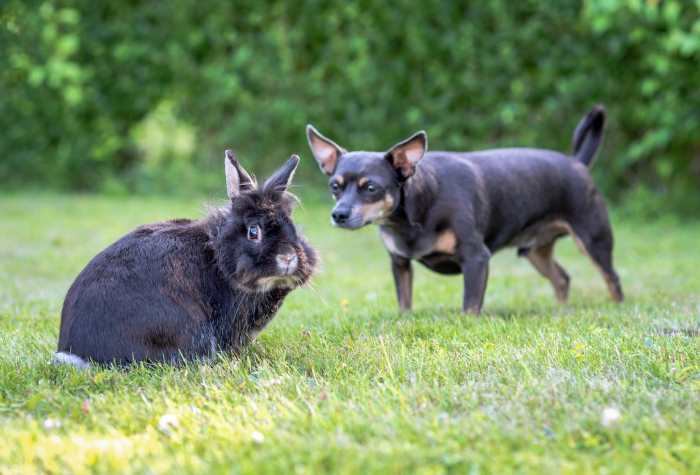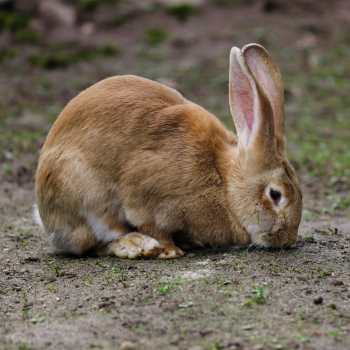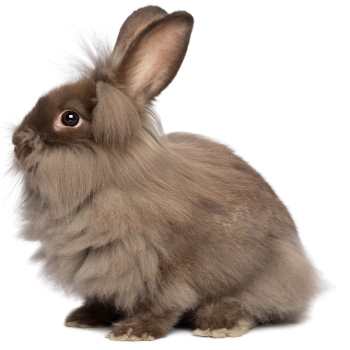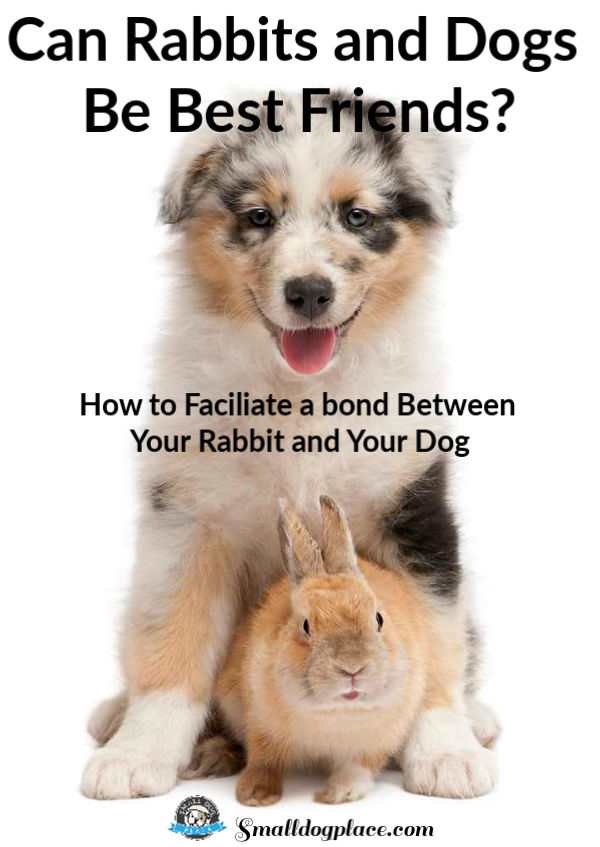- Small Dog Place Home
- Lifestyle
- Rabbits and Dogs Living Together
Can Rabbits and Dogs Be Best Friends? How to Facilitate a Bond between your rabbit and your dog.
Rabbits and Dogs By Anoop Nain
The first thing you need to understand is that some dogs are predatory animals whereas rabbits are prey. Nature has taught dogs that rabbits are a potential food source for them.
However, many rabbits and dogs share homes together quite amicably. Now, whether your two pets will be able to enjoy companionship depends majorly on your dog and your willingness to encourage the bond.

In this article, we will take you through the ideal way to bond your rabbits and dogs. But remember that in some instances, the rabbit feels hugely threatened by the dog, and a bond is just unnatural and cannot be formed. In which case, you must be prepared to keep the rabbit and dog permanently apart.
Just like dogs that belong to a specific breed, rabbits do too. Each dog breed has its characteristic personality traits, and the same can be said for rabbit breeds. Choosing an ideal dog breed that will naturally gravitate to a specific rabbit breed may be the answer to a lifetime friendship between two unlikely animals.
Consider the following ideal dog breeds. Here are some of the smaller dog breeds that would be ideal for this marriage. Although these breeds are known for having a low prey drive, it is still important to train them properly to get along with your pet rabbit.
Ideal Rabbit Breeds –
- Flemish Giant
- Lionhead rabbit
- Holland Lop
 Flemish Giant
Flemish Giant Lionhead Rabbit
Lionhead Rabbit Holland Lop
Holland LopThese are all large breeds of rabbits since they are known to be calmer and less jumpy. That being said it is challenging to generalize an entire species since they will have individual personalities. Quite naturally, some rabbits will be more nervous than other rabbits. Likewise, dog breeds that would typically have a low prey drive may mistake a rabbit for a squirrel and, as you might expect, the chase is on.
However, these mentioned breeds are your best bet.
Steps on how to create a bond between your rabbits and dogs

Step 1 - Start with friendly animals
We have already covered the first step but just want to emphasize how important this is. You must ensure that you have dog-friendly rabbits and rabbit friendly dogs. This will surely make life easier for everyone in the house and the animals themselves. We would also like to tell you which breeds of animals you should avoid –
Challenging Dog Breeds –
- Retrievers
- Labradors
- Terriers
Challenging Rabbit Breeds –
- Dutch Lop
- Mini Rex
- Netherland Dwarf
Consider the challenging dog breeds: retrievers, Labradors, and terriers. These breeds were developed centuries ago for a purpose. Each of these breeds was designed for hunting, chasing or going to ground to catch vermin or other prey that was needed or wanted by their owners.
As previously mentioned, all of these animals will have individual personalities, so it can’t be said for sure which breed will be the best or the worst. However, these are the breeds that are known to cause trouble, so you should try to avoid them.
Now, if you already have one of the above dogs or rabbits, then, of course not much can be done in that case. You just have to ensure that they are trained well and hope for the best.
Step 2 – Consult a Vet
This is an essential step and should not be missed as the health of your family, and your pets are paramount. You must ensure that you consult with your vet before bringing any new animal into your home.
You want to make sure that your current pets aren’t going to spread or be prone to any diseases. The doctor can give your pet a thorough check-up and offer special instructions for your new addition. You also want to ensure your current pets are well socialized since stressed and hurt animals are prone to aggression, making them difficult to respond to your efforts to help then bond to a new family member of a different species.
Step 3 – Pre-Introduction of Rabbits and Dogs

So, you have made up your mind and have decided to get a new animal in the house, dog or rabbit, great news! Now, there are a few things that you must ensure before you actually get the two buddies introduced. The following are a few things that you must ensure you do before their first meeting.
Step 3.1 – Training for Rabbits and Dogs
As previously mentioned, the nature of this relationship will be up to the dog in this case. Therefore, you must ensure that the dog is well trained and well behaved. All basic instructions such as sit, stay, etc. should be taught to the dog beforehand.
This can be done in a few ways – One, you can take obedience training classes by a professional. You can get recommendations from your vet for a good dog trainer. Also, some pet stores offer dog socialization and obedience classes.
Through training, your dog will learn helpful commands, but at the same time you will also be developing a strong bond with your dog. After basic training, you must also practice these commands with your dog. This will allow the dog to become familiar with your cues and will be more willing to listen to you. Slowly, the dog will become comfortable with you as an owner and an authority figure and begin to follow your cue because they want to please you.
Step 3.2 - Space for Your Rabbits and Dogs
As you would imagine, both animals will feel territorial about the space, and that is something you need to avoid.
During the introductory phase, it is essential to avoid places where the animals sleep or eat. An excellent neutral area such as the garden or family room would be ideal since those areas should make them feel more relaxed. This will allow both the animals to be relieved of any initial pressure or tension. You must also ensure that the dog is not feeling confined with a tight leash or collar.
Step 3.3. – Familiarization
Before the actual interaction, you can keep the two in separate rooms and slowly get them familiar with each other’s smells. This can be done by giving them each other’s toys or blankets while ensuring they don’t meet yet. The scent will help them become more comfortable and eased out when they actually meet.
Step 3.4 – Extra pair of hands Can't Hurt to Help Your Rabbits and Dogs Make an Aquantance
Having an extra pair of hands around the house will surely help you out. You may want to ask a friend or a family member to drop by before you are planning to introduce the two animals.
Step 4 – The Introduction of Your Rabbits and Dogs
Alright so this is the big moment, and you want to make sure that it goes right.
Firstly, you would want to keep the rabbit in a rabbit hutch. It will allow the bunny to be comfortable and at the same time prevent him from running away.
Additionally, it will also rule out any challenges that might come up due to the unpredictable nature of the interaction. You must also ensure that the dog is under your control during this time. You must ensure that all of the following activities are avoided on the part of the dog –
- Any sudden movements
- Barking
- Whining
- Pawing at the cage
Additionally, you must offer positive reinforcement to the dog which includes positive verbal cues that you have previously taught, Statements such as “good boy” or any other terms that your dog is familiar with will surely help.
Begin by sitting on the floor next to the cage and have your dog lie on his side or on his stomach with his head also down on the floor. The rabbit will not consider the dog a danger when the dog is in this submissive position.
Next, you must allow the rabbit to come out whenever he feels ready. Once again, you must not put any pressure on either of the animals at this stage. They must decide when to approach each other. They will both start sniffing each other which is natural and just fine.
The two primary goals during this stage of the process are for the bunny to feel comfortable around the dog. Patience may be necessary on your part because you don’t want to rush the two potential buddies.
Secondly, for the dog to see that the rabbit is neither a play toy and nor is he an alpha over the bunny. It is suggested that the dog remains in the previously mentioned down position. Be sure to offer plenty of praise to the dog for this demeanor.
Step 5 – Monitoring Your Rabbits and Dogs
Slowly and steadily, both animals will start getting familiar and comfortable with each other. However, you must still be vigilant throughout this time and make sure to keep an eye on them. You must ensure not to leave the two animals alone during the first few meetings. They may seem like they are getting along, but you still do not want to take any chances.
You must also keep the sessions short. Extended exposure to each other may attract risky excitement, which can lead to a challenging situation.
After some time you may go ahead and increase their playtime and then eventually allow them to interact all the time freely. Lastly, make sure that the feeding and sleeping areas are separated for both animals as this causes territorial issues.
Summary of Rabbits and Dogs
So, we hope these tips will help your rabbits and dog bond with each other. However, you must understand that patience is a virtue when it comes to animals, and the entire process may take some time. Just make sure that you give your pets enough time and space to become comfortable with each other.
Also, make sure you are keeping an eye on them and do not let anything unfortunate happen. We are confident that in no time, your pets will become best buddies.
Author Bio:
I am Anoop Nain, proud father of four rescued dogs and two Flemish giant rabbits. It’s 2019, all my puppies are grown up now, but each day with them is a new learning experience for me. I know so much about pets (dogs and rabbits in particular) now that people come to me for suggestions and tips.
About Janice (author and voice behind this site)
Having lived with dogs and cats most of her life, Janice served as a veterinary technician for ten years in Maryland and twelve years as a Shih Tzu dog breeder in Ohio.
Her education includes undergraduate degrees in Psychology with a minor in biology, Early Childhood Education, and Nursing, and a master's in Mental Health Counseling.
She is a lifelong learner, a dog lover, and passionate about the welfare of animals. Her favorite breed for over 50 years has been the Shih Tzu, but she has also lived with Poodles, Maltese, Yorkshire Terriers, Beagles, English Bulldogs, Carin Terriers, and a Cocker Spaniel.
When not writing, reading, and researching dog-related topics, she likes to spend time with her eight Shih Tzu dogs, husband, and family, as well as knitting and crocheting. She is also the voice behind Miracle Shih Tzu and Smart-Knit-Crocheting
Does This Article Deserve Your Thumbs Up?
We always appreciate your support and encouragement. Your thumbs up means so much to us. Please like this article.
If you find this page or any page on Small Dog Place Helpful, or useful in anyway, I'd love it if you would click the small heart found on the bottom right of each page.
You can also share or bookmark this page -- just click on the:

Free Monthly Newsletter
Sign Up for Our Free Newsletter and get our Free Gift to You.
my E-book, The Top 10 Mistakes People Make When Choosing a Dog (and how to avoid them)


